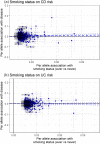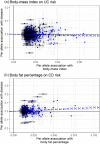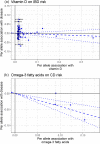Identifying environmental risk factors for inflammatory bowel diseases: a Mendelian randomization study
- PMID: 33159156
- PMCID: PMC7648100
- DOI: 10.1038/s41598-020-76361-2
Identifying environmental risk factors for inflammatory bowel diseases: a Mendelian randomization study
Abstract
Several studies have examined environmental factors and inflammatory bowel diseases (IBD) using traditional approaches; however, provided results are still conflicting. Our aim was to determine whether lifestyle and nutrient exposures, related to IBD in observational meta-analyses, influence IBD risk using a Mendelian randomization (MR) approach. A two-sample MR approach was applied on summary-level genome-wide association results. Genetic variants strongly associated with measures of tobacco smoking, obesity and fat distribution, physical activity, and blood levels of vitamins and fatty acids were evaluated on genetic data from international IBD consortia including a total of 25,042 IBD cases (12,194 cases of Crohn's disease (CD) and 12,366 cases of ulcerative colitis (UC)) and 34,915 controls. Our results indicated that, among lifestyle exposures, being a smoker was positively associated with CD (OR 1.13, P = 0.02), but it was not associated with UC risk (OR 0.99, P = 0.88). Body-mass index (BMI) and body fat percentage were positively associated with CD (OR 1.11, P = 0.02, per standard deviation (SD) of 4.6 kg/m2; and OR 1.50, P = 3 × 10-10, per SD of 6.6%; respectively); while for UC, BMI was inversely associated (OR 0.85, P = 5 × 10-5; per SD) and body fat percentage showed a OR of 1.11 (P = 0.11; per SD). Additionally, among nutrient exposures, omega-3 fatty acids levels were inversely associated with CD (OR 0.67, P = 2 × 10-6). Our MR results did not support a protective effect for being a smoker on UC risk; however, they are compatible with a risk effect for higher body fat proportion and a protective role for higher levels of omega-3 fatty acids on CD etiology.
Conflict of interest statement
The authors declare no competing interests.
Figures






References
-
- Magro F, et al. Third European Evidence-based Consensus on Diagnosis and Management of Ulcerative Colitis. Part 1: definitions, diagnosis, extra-intestinal manifestations, pregnancy, cancer surveillance, surgery, and Ileo-anal pouch disorders. J. Crohn’s Colitis. 2017;11:649–670. doi: 10.1093/ecco-jcc/jjx008. - DOI - PubMed

